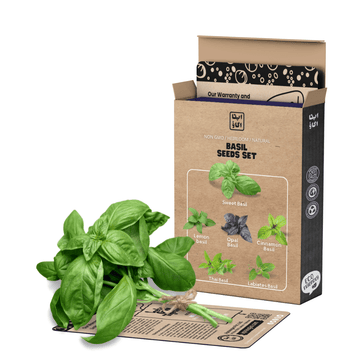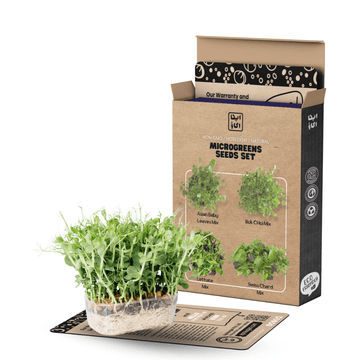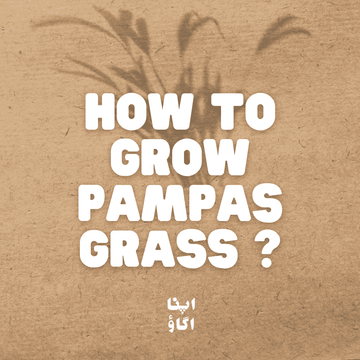Pampas Grass is a striking ornamental plant known for its silvery foliage and tall feathery plumes. It’s a low-maintenance perennial that adds drama to gardens, borders, and even large pots on terraces or rooftops. If you're looking to bring a bold, textural element into your home garden in Pakistan, this guide is for you.
🌱 Fast Facts
-
Planting Season: Spring or early Monsoon (Feb–April | July–Aug)
-
Sunlight: Full Sun
-
Watering: Moderate; drought-tolerant once established
-
Life Cycle: Perennial
-
Height: 4–6 feet
About Pampas Blue Grass
Pampas Grass (scientific name: Cortaderia selloana) is part of the ornamental grass family and known for its steel-blue foliage and dramatic flowering plumes. It thrives in hot, dry climates, making it well-suited to much of Pakistan. Once mature, it requires minimal care and is great for xeriscaping.
📆 When to Plant Pampas Blue Grass in Pakistan
| Region | Spring Season | Monsoon Season |
|---|---|---|
| Punjab, Sindh, Balochistan | Feb–April | July–August |
| KPK, Northern Areas | March–May | Not recommended due to rain sensitivity |
📌 Where to Plant
-
Choose a sunny spot — at least 6 hours of direct sun daily.
-
Plant in well-drained soil to prevent rot.
-
Suitable for open garden beds, rooftop pots, or borders.
🌾 How to Plant Pampas Grass Seeds
-
Seed Preparation: Light germinator — press gently on moist soil, do not bury.
-
Container or Bed: Use seed trays or sow directly in a pot or prepared bed.
-
Soil: Use sandy loam or potting mix enriched with organic matter.
-
Moisture: Mist the soil regularly. Don’t overwater.
-
Germination Time: 14–21 days at 20–25°C.
🌿 Growth Timeline (Vertical Format)
| Stage | Days After Planting |
|---|---|
| Starting | Day 1 |
| Sprout | Day 14–21 |
| Vegetative | Day 30–60 |
| Flowering | Day 90+ (may take longer in cooler zones) |
| Mature Form | 6 months+ for full height and bloom |
How to Care
-
Water only when the soil is dry to the touch.
-
Fertilize lightly in spring with compost or balanced NPK.
-
Prune old foliage in late winter to encourage new growth.
-
Pests/Disease: Rarely affected — it’s a hardy, self-sustaining plant.
Shop ApnaUgao Online for Growing Pampas Grass
-
Buy Pampas Blue Grass Seeds Pampas Seeds Collection – ApnaUgao
-
Grow Bags Collection
-
Organic Potting Mix
-
Vermicompost
🔁 Companion Plants
Pair with:
-
Lavender
-
Echinacea
-
Fountain Grass
Avoid growing too close to:
-
Water-demanding plants
-
Shade-loving ground covers
Scientific Variations
-
Cortaderia selloana (Common Pampas Grass)
-
Cortaderia selloana ‘Blue’ (Blue foliage cultivar)
-
Cortaderia selloana ‘Pumila’ (Compact variety)
Benefits
-
Adds architectural height to your garden.
-
Drought-tolerant and low maintenance.
-
Excellent for borders, xeriscapes, and wildlife-friendly gardens.
-
Long-lasting plumes great for dried arrangements.
❓ Q&A – Growing Pampas Blue Grass in Pakistan
Q: Is Pampas grass suitable for small gardens?
A: Yes, just choose a compact variety or use containers.
Q: How long does it take to flower?
A: Typically within 6–12 months after planting in warm climates.
Q: Does it need a lot of water?
A: No, once established, it’s drought-tolerant.
Q: Can I grow it in pots on rooftops?
A: Absolutely — use a large pot with good drainage.
Q: When is the best time to prune it?
A: Late winter or early spring before new growth starts.
Q: Can I use the plumes for decoration?
A: Yes, dried plumes make beautiful home decor.
Q: Will it survive winter in Northern Pakistan?
A: It may need protection in freezing areas — mulch around the base.
Q: Does it attract pollinators?
A: Yes, its flowers attract butterflies and birds.
Q: Can I divide it later?
A: Yes, mature clumps can be split every 2–3 years in early spring.
Q: Is it invasive?
A: It can be, so trim seed heads if you don’t want it to self-spread.
🔗 Helpful Links
Expert Tip
Once Pampas Grass is established, it will regrow every year with minimal effort. Trim back in winter to rejuvenate the plant and maintain its structure.










